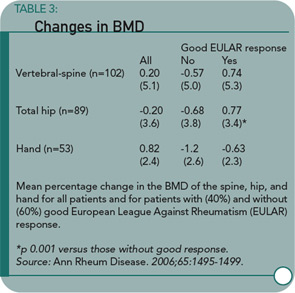BONE LOSS
Preventing Fractures in Patients with RA
By Daniel Hal Solomon, MD, MPH
Abstract
Objectives: To examine whether treatment with anti-TNF alpha prevents loss of bone mineral density (BMD) at the spine and hip (generalized) and in the hands (local) of patients with RA, and to study the changes in markers of bone metabolism, including receptor activator of the NFkappaB ligand (RANKL) and osteoprotegerin (OPG), during anti-TNF treatment.
Patients and methods: One hundred two patients with active RA who were treated with infliximab during one year were included in this open cohort study. The BMD of the spine and hip (dual X-ray absorptiometry) and hands dual X-ray radiogrammetry was measured before the start of treatment and after one year. Changes in osteocalcin formation, beta-isomerised carboxy terminal telopeptide of type 1 collagen (beta-CTx, resorption), RANKL, and OPG were determined at 0, 14, 30, and 46 weeks.
Results: The BMD of the spine and hip was unchanged during treatment with infliximab, whereas BMD of the hand decreased significantly by 0.8% (p<0.01). The BMD of the hip in patients with a good European League Against Rheumatism (EULAR) response showed a favorable change compared with patients not achieving such a response. Serum beta-CTx and RANKL were both considerably decreased compared with baseline at all time points. The decrease in beta-CTx was associated with the decrease in Disease Activity Score of 28 joints (DAS-28) and C reactive protein during the 0-14 weeks interval.
Conclusion: In patients with RA treated with infliximab, spine and hipbone loss is arrested, whereas metacarpal cortical hand bone loss is not stopped. The outcome of the study also supports a relationship between clinical response, in terms of reduced inflammatory activity, and changes in bone loss of the spine, hip, and hands.
The bone abnormalities associated with RA include juxtaarticular osteopenia, focal bone erosion, and diffuse bone loss that extends far beyond the region of the joint. Osteoporosis and the associated fractures appear increased in some groups with RA compared with controls.1 While our understanding of the pathophysiology of bone loss in RA is incomplete, many studies suggest that receptor activator of NFkB ligand (RANKL) and osteoprotegrin (OPG) play important roles in regulating bone metabolism. In turn, TNFa regulates RANKL and OPG, suggesting that the TNFa antagonists may retard not only focal bone erosions but also generalized osteoporosis among patients with RA.
This study by Vis and colleagues builds on several preliminary investigations that suggest a relationship between TNFa antagonist use and improved BMD. In this multicenter study, consecutive patients treated with infliximab for at least one year were included. These patients had all undergone dual energy X-ray absorptiometry (DEXA) measurements at baseline and at follow-up. All patients had DAS-28 scores of at least 3.2 and had previously failed at least two DMARDs. Thirty-four patients dropped out because of an inadequate response or side effects to infliximab; they were not included in the analyses.

